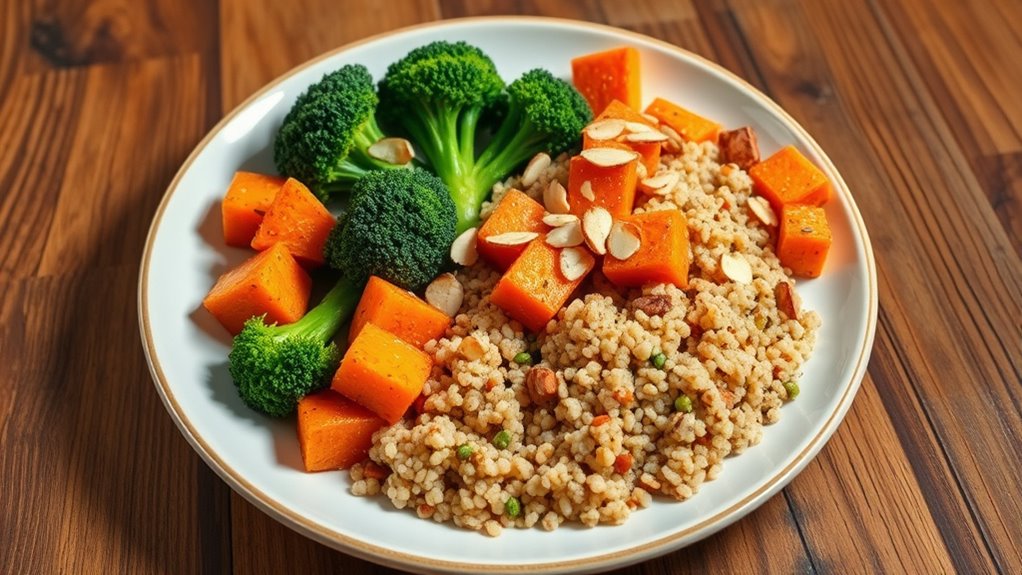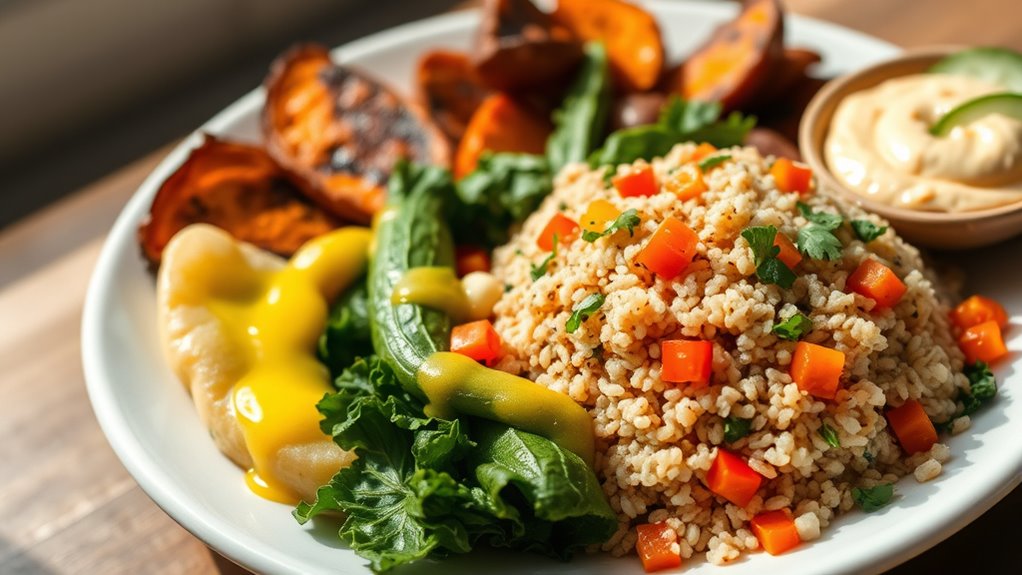To create diabetic-friendly meals with low sugars and complex carbs, focus on incorporating whole grains like quinoa and brown rice, along with plenty of non-starchy vegetables. Use ingredient substitutions such as almond flour or coconut flour to boost flavor without added sugar. Flavor dishes with herbs, spices, lemon juice, and vinegar to keep them tasty and satisfying. Keep an eye on portion sizes for balanced blood sugar and discover simple tips to make your meals healthier and more enjoyable.
Key Takeaways
- Incorporate complex carbs like quinoa, brown rice, and non-starchy vegetables to stabilize blood sugar levels.
- Use ingredient substitutions such as almond flour and coconut flour to reduce sugar and refined carbs.
- Plan meals in advance with batch cooking to ensure quick access to healthy, low-sugar options throughout the week.
- Flavor dishes with herbs, spices, lemon juice, and vinegar instead of added sugars or high-sugar sauces.
- Include lean proteins and nutrient-dense foods to promote satiety and support blood sugar control.

Managing diabetes doesn’t mean giving up delicious food; instead, it’s about making smart choices that support your health. One of the best ways to do this is by planning your meals ahead of time. Meal prep tips can help you stay on track, reduce last-minute temptations, and ensure you’re consuming the right balance of nutrients. When preparing diabetic-friendly meals, focus on incorporating complex carbs like whole grains, legumes, and vegetables. These foods digest more slowly, helping to stabilize blood sugar levels and keep you feeling full longer. To make meal prep easier and more enjoyable, consider ingredient substitutions that boost flavor without adding extra sugar or unhealthy fats.
Smart meal planning with whole grains and veggie swaps supports healthy blood sugar levels.
For example, swap white rice for quinoa or brown rice, which provide fiber and have a lower glycemic index. Instead of using refined flour, try almond or coconut flour for baking or thickening sauces. Not only do these substitutions add nutritional value, but they also enhance the taste and texture of your dishes. Incorporate plenty of non-starchy vegetables like leafy greens, peppers, and broccoli into your meals. These vegetables are low in carbs but high in fiber and essential nutrients, making them perfect for maintaining steady blood sugar levels. Additionally, choosing keto-friendly ingredients can help you keep carbs in check while still enjoying flavorful meals.
When planning your weekly meals, think about how you can incorporate healthy protein sources such as lean poultry, fish, tofu, or legumes. These proteins help control blood sugar spikes and keep you satisfied longer. To add variety, experiment with different herbs and spices—cinnamon, turmeric, garlic—these not only flavor your dishes but may also offer additional health benefits. Keep in mind that portion control is key; even healthy foods can impact blood sugar if eaten in excess.
Meal prep tips also include batching dishes so you have healthy options ready to go throughout the week. For instance, cook a large batch of roasted vegetables and grains, then divide them into containers for quick lunches and dinners. When it comes to ingredient substitutions, don’t be afraid to get creative. Swap out high-sugar sauces for homemade vinaigrettes or tomato-based sauces with herbs for flavor. Using fresh herbs, lemon juice, and vinegar can add zest without extra calories or sugar.
Ultimately, managing diabetes involves consistent, mindful eating that emphasizes whole, nutrient-dense foods. With good meal prep habits and strategic ingredient substitutions, you can enjoy flavorful, satisfying meals that support your health goals. Remember, making small adjustments today leads to healthier habits tomorrow, and you don’t have to sacrifice taste for wellness.
Frequently Asked Questions
Can Diabetics Eat Fruit Daily?
Yes, you can eat fruit daily, but it’s important to choose the right fruit variety and control your daily intake. Opt for berries, apples, or citrus, which are lower in sugar and rich in fiber. Keep portions moderate to prevent blood sugar spikes. Incorporating a variety of fruits into your meals helps you enjoy the benefits without overdoing it. Always monitor your blood sugar levels to see how different fruits affect you personally.
Are Gluten-Free Carbs Better for Diabetes?
You might think gluten-free carbs are better for diabetes, but that’s not always true. Gluten alternatives like rice or corn can still cause rapid carb absorption, raising blood sugar levels. It’s more important to focus on the type of carbs and their complex nature, which slow absorption. So, choose whole, unprocessed options and watch portion sizes to better manage your blood sugar, regardless of gluten content.
How Do Portion Sizes Affect Blood Sugar?
Portion control plays a vital role in managing your blood sugar levels. When you eat larger portions, your blood sugar can spike, even if the food is healthy. By controlling your portion sizes, you help your body process carbs more effectively, avoiding sudden increases. Keep mindful of serving sizes, and aim for balanced portions to maintain steady blood sugar, supporting your overall diabetes management and health.
Can I Substitute Honey in Recipes?
Think of honey as a golden river flowing through your recipe; you can often replace it with natural sweeteners like stevia or monk fruit, which are like clear mountain streams—sweet yet low in sugar. Honey alternatives work well, but remember, they may alter flavor and consistency. Always taste and adjust your recipe, ensuring you maintain balance while enjoying the natural sweetness without spiking your blood sugar.
What Snacks Are Suitable Between Meals?
You should choose healthy snack swaps like raw nuts, seeds, or veggie sticks with hummus. Opt for fiber-rich options like fresh berries, apple slices, or whole-grain crackers to keep your blood sugar stable. These snacks provide sustained energy and help satisfy your hunger between meals. Avoid sugary chips or candy, and focus on wholesome, nutrient-dense choices to support your overall health and maintain balanced blood sugar levels.
Conclusion
Imagine sitting down to a vibrant plate filled with colorful veggies, hearty whole grains, and tender lean proteins—all crafted to keep your blood sugar steady. These diabetic-friendly meals aren’t just nourishing; they’re a celebration of flavor and health. With every bite, you’re fueling your body with complex carbs that sustain you and satisfy your cravings. Embrace these recipes and transform your mealtime into a comforting, energizing experience you look forward to every day.









